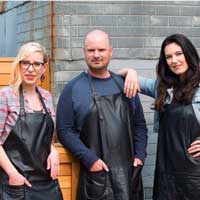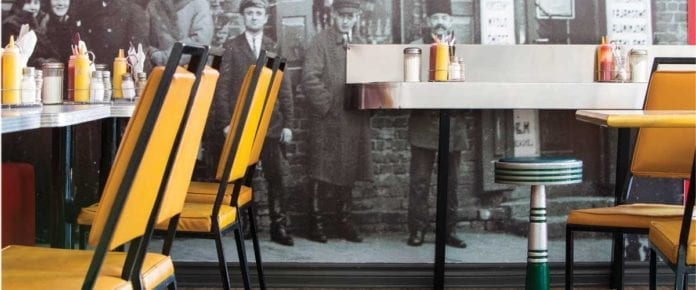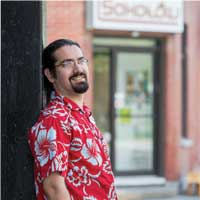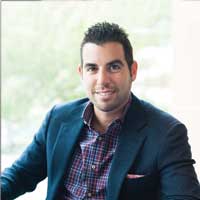Charbar
 What’s behind the launch of the unique Charbar concept in Calgary’s historic Simmons Building in the city’s East Village: a butcher, a baker and a coffee maker. The latest offering from the talented team that developed Charcut is all about collaboration and seizing opportunities when they’re presented.
What’s behind the launch of the unique Charbar concept in Calgary’s historic Simmons Building in the city’s East Village: a butcher, a baker and a coffee maker. The latest offering from the talented team that developed Charcut is all about collaboration and seizing opportunities when they’re presented.
“The Simmons Building is a landmark and has been such an integral part of Calgary’s history,” explains Charbar co-owner/executive chef Jessica Pelland. “We’ve always wondered what would become of it as the East Village started to develop.” Until four years ago, that is. That’s when Sebastian Sztabzyb of Calgary-based Phil & Sebastian Coffee Roasters approached Pelland and Charcut owners Connie DeSousa and John Jackson about the opportunity to collaborate and respond to an Expression of Interest call from building owners The Calgary Municipal Land Corporation (CMLC).
“The concept showcased three hyper-local businesses [Charbar, Phil & Sebastian Coffee Roasters, and Sidewalk Citizen Bakery] working collaboratively under one roof. We weren’t looking for this location, it truly found us and it has grown into the incredible collaboration you see today.”
Preserving a Piece of History
The primary challenge the team faced during the construction phase was modernizing the building’s structure and systems while preserving and restoring elements with significant heritage value. Calgary-based McKinley Burkart designed the space and all three tenants were heavily involved.
While creating a culinary destination was top of mind, great care was taken when restoring the original design features to ensure the heritage of the building was respected. “With the unique dynamic of all three businesses, it was so exciting to work together alongside McKinley Burkart because we were able to integrate all of our visions into the space,” says Pelland.
Many elements inside the building became part of the incredible design features such as the building’s original feather chute with its pulley system and weights located on the second floor in the private dining room. “It’s a wonderful discussion piece because it represents the essence of what the Simmons Building was,” says Pelland.
The total cost of the project for the Simmons Building was in excess of $10 million, which included the improvements made to the base building. The costs were divided among the three tenants, with Charbar’s share coming from the ownership group as well as close friends and family who were smaller investors.
Lay of the Land
At more than 16,000 sq. ft., the Simmons Building had more than enough space to go around and was divided between the three tenants based on what each required to operate and execute their businesses. “We share the space and there’s a lot of crossover involved,” says Pelland. “This is what makes the space unique and always energized. The one area that is not divided is our rooftop patio, which is almost 3,000 sq. ft. and has approximately 100 seats.”
For Charbar and the other two tenants, the project started four years ago, but the actual build took less than a year. “CRW and Peter Mirosevic, our contractor, were ahead of schedule,” says Pelland. “Garnet and James, our on-site supervisors, ensured that the layout of the building was thoughtful and catered to our needs. This team was also responsible for building Charcut in 2009/2010 — also ahead of schedule.”
Nuts and Bolts
A new restaurant needs new equipment and Charbar was lucky enough to be working with a “healthy” budget, says Pelland. The eatery was able to tap into existing strong relationships with local suppliers such as Hendrix Restaurant Equipment & Supplies.
“Our equipment budget was dependent on our primary needs,” says Pelland. “From our Rational ovens in the production kitchen to the two wood-fired grills, Charcut has enabled us to prepare for this new space.”
The pièce-de-résistance is the parilla, wood-fired Argentine-style grill from U.S.-based Grillworks. “Owner Ben Eisendrath and I had been planning the parilla since 2012,” says Pelland. “It is now the focal point of Charbar and the essence of the restaurant.”
Similarly, ingredients are sourced locally using the relationships established from Charcut. “Our relationships with local farmers, ranchers and artisan producers have been cultivated over time and support local, sustainable ingredients,” Pelland explains. “For some of our items, we do need to source outside of our local contacts, such as Peter’s Skyhawk olive oil from Angel Camp, California. We’ve been using his product for over 10 years because we know it’s a good product.”
From Farm to Table
Charbar has quickly made a name for itself as a culinary destination with menu items such as pistachio and avocado bruschetta ($12), tableside ceviche mixto with tiger’s milk and cancha ($19) and the fire pit asador platter for meat lovers ($36 per person).
“We see Charbar as an evolutionary step from Charcut, drawing on international inspiration from our mentors, peers and food lovers everywhere,” says Pelland, reflecting on the new menu. “Charbar’s menu was heavily influenced by our travels — particularly to Argentina. We were so taken by the culinary techniques, particularly the wood-fired grilling tradition of Argentina, that we wanted Calgarians and visitors to experience it.”
Pelland has created a menu that is a departure from Charcut’s meat-centric offerings. “It’s not cuisine or ingredient-specific,” she says. “We have seafood, our dry-aged beef and almost half the menu [items] are vegetarian dishes.”
Making Waves
The Simmons Building is the first of its kind to house three culinary businesses and according to Pelland, response has been overwhelming. “The support of our city has been incredible. We are much busier than we forecasted and are continuing to see an increase moving into our third month of business. It truly is a culinary destination, created by locals, bringing locals, but made for everyone.”
Leonard Cohen may have sat at this table.” That’s something Shayne Gryn likes to tell customers when they slide into one of the vintage booths that used to reside at Bens De Luxe Delicatessen and Restaurant — a downtown Montreal landmark credited with inventing smoked meat. “There’s National Film Board of Canada documentary footage of a young [Leonard] Cohen hanging out there in the middle of the night,” says Gryn, “so who really knows?”
The tables, like the old-school arcade cabinet filled with classic Atari and midway games, are part of the comfortable, old-style diner feel Gryn was striving for when he opened Deli Sokolow with his business partner Leah Freeman in April 2015.
“I had some basic ideas of what I wanted for the general look and feel,” he says. “But the proper design work was done by David Lemelin from Ottawa, who came up with the layout, placement and flow, as well as the colour scheme. Bernard Lanteigne from [Rosemont, Que.-based] Lost Vintage was integral in supplying our tables, chairs, stools and lamps, which really are what gives the place a vintage feel.”
Located in the former Restaurant John, a Montreal landmark since 1919, Deli Sokolow is named for the village in Poland where Gryn’s grandmother grew up. “The location came first, before the idea for the restaurant. I’ve lived in this neighbourhood for 12 years now and Restaurant John was my former breakfast hangout. When [the space] became available, I jumped at the opportunity. Deli ownership was an idea that I’d tossed around loosely over the last few years, but once this location became available, that’s when I decided it was time to take the plunge.”
Starting From Scratch
The space had been gutted by a fire, so Gryn found himself faced with an empty box to work with — one with far less infrastructure than he’d originally thought, based on early visits. “When I started, all I knew was that I wanted a giant black-and-white mural, red walls and a counter with stools. David [Lemelin] told me where to stick the mural, what shade of red to use and how to place our counters,” he remembers. The 1,800-sq.-ft. space — one third of which is taken up by the kitchen — seats 43 people.
The total cost of renovations, which took just shy of a year to complete, and equipment cost of about $100,000 was financed primarily by Gryn and Freeman, with support from the bank and private lenders. “I’d be lying if I didn’t say there were financial challenges,” says Gryn. “After several years of working in IT, I made the move to pursue music and theatre full time, occasionally supplementing my income with kitchen work. So I’ve lived as a starving artist. Now I’m not starving.”
The kitchen equipment rang in at about $20,000, “not counting the hood, with another $8,000 for the dairy bar equipment and $5,000 on the rest. We were also lucky enough to inherit some of the Restaurant John equipment that survived the fire.”
A Taste of Home
Gryn’s goal was to strike a balance between traditional Polish-Jewish cooking and deli fare — with some modern twists. “It was a very iterative process,” he explains, “and we did our best to make sure we weren’t ordering too wide a variety of ingredients so that we could minimize waste. Even then, with all the basic ingredients, it was still tempting to let the menu swell out of control. We also make a point of using our blackboards for daily specials so we can shift the content depending on what we buy seasonally without having to commit to the permanent menu.”
The kitchen is a collaborative environment, explains Gryn, with many of the recipes borrowed from his own family cookbook. Gryn is not the chef, he emphasizes, although he does spend time in the kitchen along with his front-of-house duties. “I hired a couple of experienced smoked-meat cutters because that’s something I didn’t have background in,” he says, “and Jo-Ann Volikakis, who does all of our baking, is the granddaughter of John from Restaurant John — so we’re maintaining some family legacy there as well.”
The menu runs the gamut from traditional deli favourites such as smoked meat sandwiches ($10 and for $5 extra you can add fries, coleslaw and a pickle), burgers (from $4.50) and matzo ball soup ($4.50); to homemade Polish comfort food such as a pierogies-and-Borscht combo ($10) and an all-day breakfast menu featuring French toast made with challah bread ($4). “But what we instantly became known for was the Latke Poutine ($8), which is three potato latkes served with cheese curds and gravy,” explains Gryn.
According to Gryn, Deli Sokolow filled a need in this Montreal neighbourhood. “The [neighbourhood] has been really supportive since day one,” he says. “We get a lot of people come in thanking us for opening what the neighbourhood needed, which is a welcoming and affordable snack bar and diner. There are a lot of restaurants, especially new ones, in St-Henri, but nobody else in the southwest of Montreal offers premium dry-cured hand sliced smoked meat and Latke Poutine hasn’t caught on anywhere else quite yet.”
As president of Chase Hospitality Group, Steven Salm gets to work in some of Toronto’s most beautiful spaces and Kasa Moto is no exception. Officially opened on May 28, the two-storey Japanese restaurant in the heart of Yorkville boasts a sprawling rooftop terrace, wood ceilings and lush indoor topiary.
Built on the site of the old Remys Restaurat — a Yorkville landmark and one of Toronto’s most popular patios — Kasa Moto was designed by II By IV, who also designed Chase restaurants Colette and Little Fin. The space features natural walnut and oak finishes complemented by Japanese-inspired elements such as dramatic lighting and a minimalist colour palette.
“We had been looking for a Yorkville location for a while,” says Salm. “When Remys closed, we heard that a new investment group went in to take over the space. We approached them midway through construction and presented an opportunity to partner and build up the space.” Salm explains that the gentrification and the urbanization of the Yorkville neighbourhood is what attracted his group to the area. “There are a lot of new residents coming to town and a lot of people’s businesses are moving further north, yet I feel it’s still an underserviced area.”
Bumps in the Road
The partnership, consisting of Chase Hospitality Group, Adam Arviv and Mark Silver, met with a number of construction hurdles during the build, which took just under a year, not the least of which was a fire that happened mid-way through construction, setting the project back more than two months. “This was certainly a challenging build for us since it had so many different variables and components making up the design and its multiple kitchens and production spaces,” says Salm. “But we ended up with a beautiful product.”
Kasa Moto’s 13,000 sq. ft. is shared between the sushi bar/lounge, Bar Moto, the main dining room, which also offers private dining and the rooftop patio. A total of 405 seats are serviced by 180 staff. “There are many different components to what makes up Kasa Moto,” says Salm, “and they all have their own design visions so the design intent varied from space to space. Most importantly, we wanted it to feel sexy, luxurious and evening-oriented, but still be a place where families would be comfortable. “We’ve captured many audiences but, overall, the theme is very aesthetically mysterious, chic and fun.”
Construction materials were sourced locally where possible but some items, says Salm, had to be imported from Japan.
Inspired by the Outdoors
Salm says the vision for Kasa Moto came about the same way Chase Hospitality Group conceptualizes all of its restaurants. “We really base it on location — as in the way the real estate makes us feel — and in this situation it came down to how can we ignore the fact that there’s a 6,000-sq.-ft. rooftop terrace that really transported you to an oasis that was not Toronto?”
With so much business coming from the terrace, Salm says it was important to consider what type of food people want to eat when they are outdoors. “Heavy foods like steak and pasta are probably a little too rich for that outdoor setting, so the idea of doing sushi and Japanese originally fuelled the Kasa Moto concept. As we started evolving, we began to realize that the sophistication and the elegance of Japanese cuisine could be applied to our normal standards in the downstairs spaces as well.”
In the Kitchen
Kasa Moto’s kitchen is led by three chefs: Executive chef Michael Parubocki from Four Seasons’ Truffles and Momofuku, chef de cuisine Daisuke Izutsu from Don Don Izakaya, and Kaiseki Sakura and Sushi chef Tsuyoshi Yoshinaga from Yasu and Sushi Kaji. “It’s an interesting and pretty amazing combination of talents,” says Salm. “They have an incredible relationship for marrying all of their traditions and upbringings into the culinary program.”
The seasonal menu reflects local and imported ingredients alike and has changing daily features, allowing for a unique meal at each visit. Menu development included Salm’s vision as well as best practices from leaders in the U.S., Europe and Japan. “These styles of restaurants are less and less popular in Japan and more and more popular in North America because it really is not the most traditional Japanese — it has a fusion of a number of techniques and flavours,” says Salm.
The menu features standout favourites such as spicy tuna on crispy rice with chili and jalapeño ($13), rock shrimp tempura with yuzu pepper aioli and wasabi ($16) and lobster tempura with wasabi sour cream, sansho salt and sesame chimichurri (market price). “It’s a greatest-hits menu,” says Salm.
So far, Kasa Moto is a hit with customers. “The reception to what we’re doing has been very positive,” says Salm. “It’s just getting us more and more excited for what’s to come.”
Kasa Moto started serving brunch in September and will unveil a new menu in the fall. “Believe it or not, I think the success so far is only a prelude to what’s to come. I The creative energy behind the next menu change and brunch is going to be pretty spectacular.” l




![Redberry Restaurants Becomes Canada’s Area Director for Jersey Mike’s Subs Expansion Redberry Jersey Mike’s Subs - Paul Pascal (left), director of Operations, and Stephen Scarrow (right), senior Marketing manager]](https://www.foodserviceandhospitality.com/wp-content/uploads/2024/04/Redberry-Appointments-218x150.jpg)















